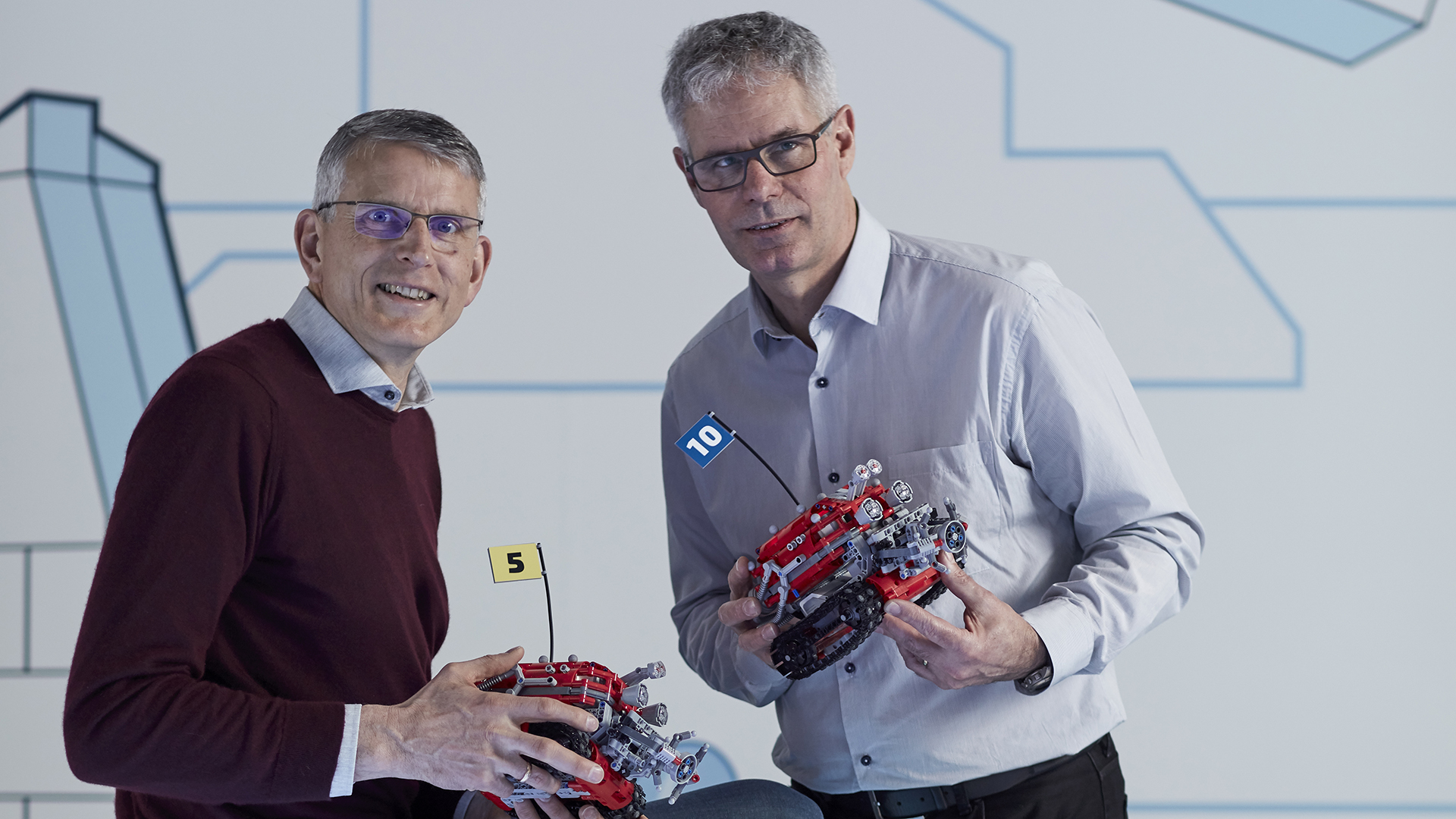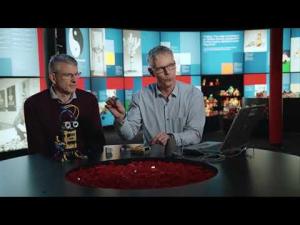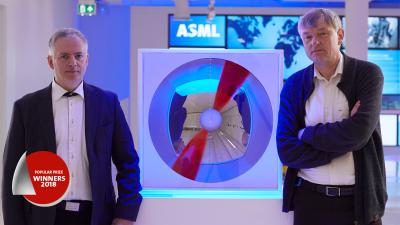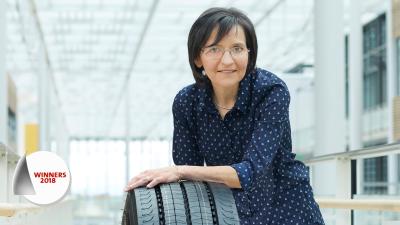Gaute Munch, Erik Hansen and team
LEGO programmable robots
Finalists for the European Inventor Award 2018
Millions have learned the basics of computer coding thanks to programmable robotic toy construction kits from Danish company LEGO. Developed by Gaute Munch and an international team including Erik Hansen, the kits – LEGO MINDSTORMS – first came to market in 1998. Now in their third generation, they continue to attract, educate and fascinate millions of young enthusiasts and school children.
In the mid-1980s, the field of robotics was still the exclusive domain of government think tanks and scientific institutions. But sensing the potential of combining the creativity of its building bricks with computer technology, LEGO began a partnership with the Media Lab at the Massachusetts Institute of Technology (MIT) in Boston, United States.
In 1994, the team at MIT, with support from LEGO and the United States National Science Foundation, developed a LEGO brick with a small computer inside, known as the "MIT Programmable Brick" or "Model 120". This minicomputer could be programmed to activate switches and motors - to move the arms of a robot, for example - in a text-based coding language called Brick Logo. It was an instant hit in the tech community - but too complicated for kids.
Developing the concept into a market-ready product, Munch and team replaced text coding with a child-friendly graphical interface for personal computers (PCs). They filed several key patents, including for the communication protocol between PCs and the programmable brick, with commands issued through pulses of visible light.
First released in 1998, the LEGO MINDSTORMS system today has millions of users who enjoy creating and sharing their homespun robot designs.
Societal benefit
Before the invention, courses in robotics were still an exception in school curricula. MINDSTORMS changed the paradigm and LEGO has been offering specific robot construction kits for schools since 1998. School children can also compete in an annual robotics design contest, the FIRST LEGO League. In 2017, more than 200 000 did so in 30 000 teams worldwide.
The world needs young programmers: a recent report found that 40% of people in the European Union have "insufficient" digital skills, while 22% have none. Although the information and computer technology (ICT) sector is creating 120 000 new jobs per year, Europe could face a shortage of more than 756 000 skilled ICT workers as soon as 2020. According to the inventors, the robotic toys are already helping to create a new generation of ICT talent.
Economic benefit
MINDSTORMS has continued the story of LEGO - named after the Danish expression "leg godt" ("play well") - into the computer age. In 1949, LEGO sold its first modular building blocks, called Automatic Binding Bricks. In 1958, it patented the brick design that has remained practically unchanged ever since. Over 200 billion LEGO parts have been produced to date.
The MINDSTORMS series has been a bestseller for LEGO, and the product is now in its third generation. It has won several toy industry awards, including the Toy Association's Educational Toy of the Year award. Patents awarded to Munch and team are powering follow-ups like the LEGO Boost series and WeDo 2.0 programmable kits.
With headquarters in Billund, Denmark, the LEGO Group was ranked as the world's third-largest toy manufacturer in 2016. In 2017, LEGO reported EUR 4.7 billion in revenues and profits of EUR 1 billion. LEGO employs an estimated 17 000 people around the world.
How it works
The "brain" of the LEGO MINDSTORMS system is a battery-powered miniature computer that controls robotic building blocks such as sensors and small motors. The first-generation computer was called the RCX, which connected to a PC over an infrared connection.
Users program the brick computer with functions - so-called "behaviours", such as controlling a motor under certain conditions - through the MINDSTORMS software on their PCs. The MINDSTORMS construction kits also include detailed building plans, which LEGO calls challenges, to create robotic arms, automatic doors and delivery robots out of LEGO bricks.
The system has evolved considerably since the first programmable bricks with only 32 kB of RAM. The current brick, called the EV3, runs on a LINUX operating system powered by a 300 MHz ARM9 controller with 16 MB of flash memory and has a built-in screen with a resolution of 178 x 128 pixels. In addition to large and medium motors, current MINDSTORMS sets include touch, colour, infrared and even gyroscopic sensors for a wide range of user-designed robots.
The inventors
Gaute Munch has taken part in ambitious sailing projects, even sailing across the Atlantic Ocean from Denmark to the Caribbean Islands. Since his pre-university days he has enjoyed working with young people, involving them in sailing projects.
After earning his degree in Electrical Engineering from Aarhus University in 1993, Munch joined the sensor team at Italian industrial components manufacturer Carlo Gavazzi, where he obtained his first European patent for a new type of capacitive proximity sensor.
He started working for the LEGO Group in 1997 and today is its Technology Frontend Director. Munch is named as the inventor on key patents behind LEGO MINDSTORMS and follow-up LEGO coding products. Today, he stays connected with his young audience through LEGO MINDSTORMS education and league events as well as R&D focus groups.
Erik Hansen developed his first invention as a young boy: a biscuit cutter, still used by his mother, based on a discarded oil filter from a 1952 Ferguson tractor. He joined the LEGO Company in 1985 and worked on a range of products that paved the way for LEGO MINDSTORMS.
Today, working in LEGO's Creative Play Lab, Hansen collaborates with leading universities and companies large and small to create educational toys for children. Still a passionate tinkerer, the electrical engineer with a degree in business innovation has built a sustainable heating system for his farmhouse - controlled by a LEGO MINDSTORMS robot.
Did you know?
Initially developed in close co-operation with the Media Lab at MIT, LEGO's programmable robot construction kits are not the only toys with origins in scientific research.
The Super Soaker water pistol owes its high-pressure water output to a mechanism invented (and patented) by American inventor Lonnie G. Johnson for an environmentally friendly heat pump. The Play-Doh modelling compound, another blockbuster toy franchise, was formulated by chemist Joseph McVicker as a cleaning paste for wallpaper in the 1950s.
The famous Rubik's Cube was originally designed and patented in 1974 by Ernő Rubik as a puzzle to teach students 3-D geometry. Over 400 million Rubik's Cubes have been sold over the years, and the Hungarian inventor shared his scientific expertise as a jury member on a past European Inventor Award.
The list also includes Artur Fischer, inventor of the Fischer Dübel, a small plastic wall plug, and the Fischertechnik construction toy. The winner in the "Lifetime achievement" category at the 2014 European Inventor Award, Fischer famously said: "Let the children play - we have to keep the child within us if we want to be rich in invention."
Media gallery
Contact
European Inventor Award and Young Inventors Prize queries:
european-inventor@epo.org Subscribe to the European Inventor Award newsletterMedia-related queries:
Contact our Press team#InventorAward #YoungInventors









